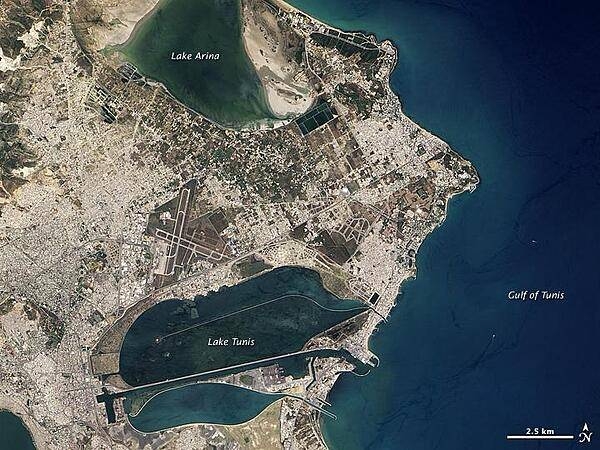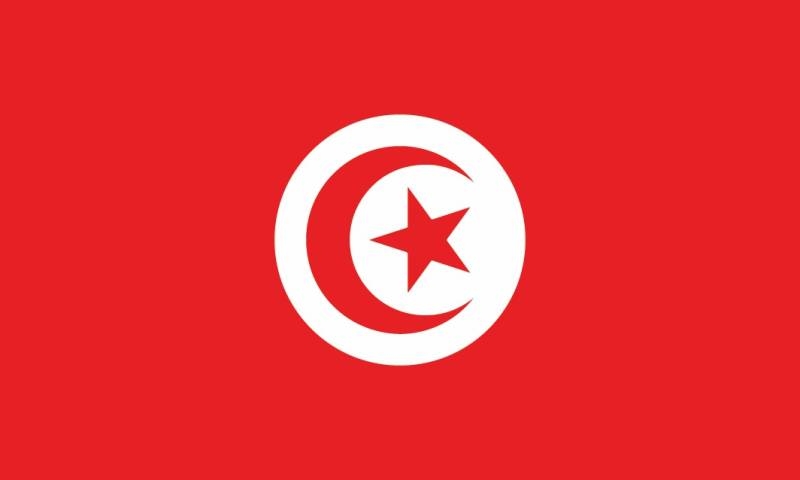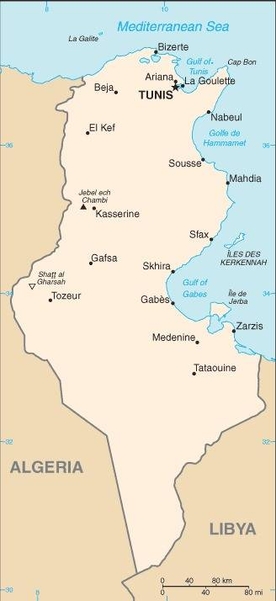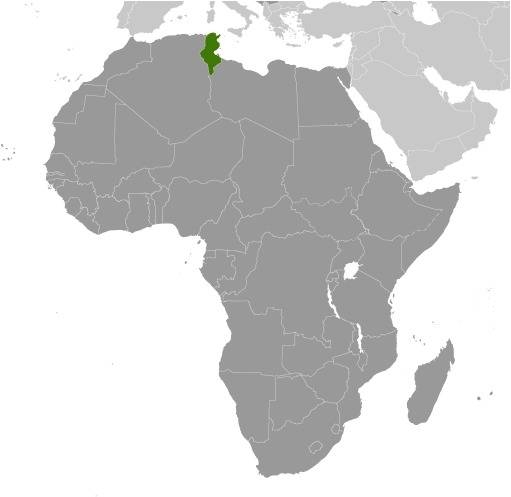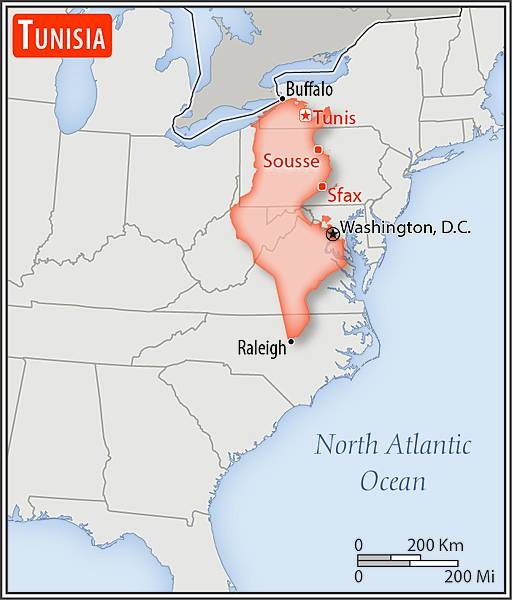Tunisia
Introduction
Background
Tunisia has been the nexus of many different colonizations including those of the Phoenicians (as early as the 12 century B.C.), the Carthaginians, Romans, Vandals, Byzantines, various Arab and Berber kingdoms, and the Ottomans (16th to late 19th centuries). Rivalry between French and Italian interests in Tunisia culminated in a French invasion in 1881 and the creation of a protectorate. Agitation for independence in the decades following World War I was finally successful in convincing the French to recognize Tunisia as an independent state in 1956. The country's first president, Habib BOURGUIBA, established a strict one-party state. He dominated the country for 31 years, repressing Islamic fundamentalism and establishing rights for women unmatched by any other Arab nation. In November 1987, BOURGUIBA was removed from office and replaced by Zine el Abidine BEN ALI in a bloodless coup. Street protests that began in Tunis in December 2010 over high unemployment, corruption, widespread poverty, and high food prices escalated in January 2011, culminating in rioting that led to hundreds of deaths. On 14 January 2011, the same day BEN ALI dismissed the government, he fled the country, and by late January 2011, a "national unity government" was formed. Elections for the new Constituent Assembly were held in late October 2011, and in December, it elected human rights activist Moncef MARZOUKI as interim president. The Assembly began drafting a new constitution in February 2012 and, after several iterations and a months-long political crisis that stalled the transition, ratified the document in January 2014. Parliamentary and presidential elections for a permanent government were held at the end of 2014. Beji CAID ESSEBSI was elected as the first president under the country's new constitution. Following ESSEBSI’s death in office in July 2019, Tunisia moved its scheduled presidential election forward two months and after two rounds of voting, Kais SAIED was sworn in as president in October 2019. Tunisia also held legislative elections on schedule in October 2019. SAIED's term, as well as that of Tunisia's 217-member parliament, expires in 2024. On 25 July 2021, SAIED seized exceptional powers allowed under Tunisia's constitution to fire the prime minister and suspend the legislature.
Visit the Definitions and Notes page to view a description of each topic.
Geography
Location
Northern Africa, bordering the Mediterranean Sea, between Algeria and Libya
Geographic coordinates
34 00 N, 9 00 E
Map references
Africa
Land boundaries
total: 1,495 km
border countries (2): Algeria 1,034 km; Libya 461 km
Coastline
1,148 km
Maritime claims
territorial sea: 12 nm
contiguous zone: 24 nm
exclusive economic zone: 12 nm
Climate
temperate in north with mild, rainy winters and hot, dry summers; desert in south
Terrain
mountains in north; hot, dry central plain; semiarid south merges into the Sahara
Elevation
highest point: Jebel ech Chambi 1,544 m
lowest point: Shatt al Gharsah -17 m
mean elevation: 246 m
Natural resources
petroleum, phosphates, iron ore, lead, zinc, salt
Land use
agricultural land: 64.8% (2018 est.)
arable land: 18.3% (2018 est.)
permanent crops: 15.4% (2018 est.)
permanent pasture: 31.1% (2018 est.)
forest: 6.6% (2018 est.)
other: 28.6% (2018 est.)
Irrigated land
3,920 sq km (2013)
Major aquifers
North Western Sahara Aquifer System
Population distribution
the overwhelming majority of the population is located in the northern half of the country; the south remains largely underpopulated as shown in this population distribution map
Natural hazards
flooding; earthquakes; droughts
Geography - note
strategic location in central Mediterranean; Malta and Tunisia are discussing the commercial exploitation of the continental shelf between their countries, particularly for oil exploration
People and Society
Nationality
noun: Tunisian(s)
adjective: Tunisian
Ethnic groups
Arab 98%, European 1%, Jewish and other 1%
Languages
Arabic (official, one of the languages of commerce), French (commerce), Berber (Tamazight); note - despite having no official status, French plays a major role in the country and is spoken by about two thirds of the population
major-language sample(s):
كتاب حقائق العالم، أحسن كتاب تتعلم به المعلومات الأساسية (Arabic)
The World Factbook, une source indispensable d'informations de base. (French)
The World Factbook, the indispensable source for basic information.
Religions
Muslim (official; Sunni) 99%, other (includes Christian, Jewish, Shia Muslim, and Baha'i) <1%
Demographic profile
The Tunisian Government took steps in the 1960s to decrease population growth and gender inequality in order to improve socioeconomic development. Through its introduction of a national family planning program (the first in Africa) and by raising the legal age of marriage, Tunisia rapidly reduced its total fertility rate from about 7 children per woman in 1960 to 2 today. Unlike many of its North African and Middle Eastern neighbors, Tunisia will soon be shifting from being a youth-bulge country to having a transitional age structure, characterized by lower fertility and mortality rates, a slower population growth rate, a rising median age, and a longer average life expectancy.
Currently, the sizable young working-age population is straining Tunisia’s labor market and education and health care systems. Persistent high unemployment among Tunisia’s growing workforce, particularly its increasing number of university graduates and women, was a key factor in the uprisings that led to the overthrow of the BEN ALI regime in 2011. In the near term, Tunisia’s large number of jobless young, working-age adults; deficiencies in primary and secondary education; and the ongoing lack of job creation and skills mismatches could contribute to future unrest. In the longer term, a sustained low fertility rate will shrink future youth cohorts and alleviate demographic pressure on Tunisia’s labor market, but employment and education hurdles will still need to be addressed.
Tunisia has a history of labor emigration. In the 1960s, workers migrated to European countries to escape poor economic conditions and to fill Europe’s need for low-skilled labor in construction and manufacturing. The Tunisian Government signed bilateral labor agreements with France, Germany, Belgium, Hungary, and the Netherlands, with the expectation that Tunisian workers would eventually return home. At the same time, growing numbers of Tunisians headed to Libya, often illegally, to work in the expanding oil industry. In the mid-1970s, with European countries beginning to restrict immigration and Tunisian-Libyan tensions brewing, Tunisian economic migrants turned toward the Gulf countries. After mass expulsions from Libya in 1983, Tunisian migrants increasingly sought family reunification in Europe or moved illegally to southern Europe, while Tunisia itself developed into a transit point for Sub-Saharan migrants heading to Europe.
Following the ousting of BEN ALI in 2011, the illegal migration of unemployed Tunisian youths to Italy and onward to France soared into the tens of thousands. Thousands more Tunisian and foreign workers escaping civil war in Libya flooded into Tunisia and joined the exodus. A readmission agreement signed by Italy and Tunisia in April 2011 helped stem the outflow, leaving Tunisia and international organizations to repatriate, resettle, or accommodate some 1 million Libyans and third-country nationals.
Age structure
0-14 years: 25.28% (male 1,529,834/female 1,433,357)
15-24 years: 12.9% (male 766,331/female 745,888)
25-54 years: 42.85% (male 2,445,751/female 2,576,335)
55-64 years: 10.12% (male 587,481/female 598,140)
65 years and over: 8.86% (male 491,602/female 546,458) (2020 est.)
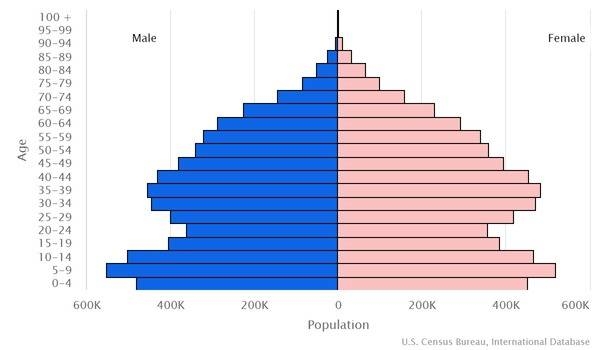
Dependency ratios
total dependency ratio: 50.9
youth dependency ratio: 36.3
elderly dependency ratio: 13.3
potential support ratio: 7.5 (2021 est.)
Median age
total: 32.7 years
male: 32 years
female: 33.3 years (2020 est.)
Population distribution
the overwhelming majority of the population is located in the northern half of the country; the south remains largely underpopulated as shown in this population distribution map
Urbanization
urban population: 70.5% of total population (2023)
rate of urbanization: 1.34% annual rate of change (2020-25 est.)
Major urban areas - population
2.475 million TUNIS (capital) (2023)
Sex ratio
at birth: 1.06 male(s)/female
0-14 years: 1.07 male(s)/female
15-24 years: 1.03 male(s)/female
25-54 years: 0.95 male(s)/female
55-64 years: 0.96 male(s)/female
65 years and over: 0.78 male(s)/female
total population: 0.98 male(s)/female (2022 est.)
Maternal mortality ratio
43 deaths/100,000 live births (2017 est.)
country comparison to the world: 99Infant mortality rate
total: 11.87 deaths/1,000 live births
male: 13.32 deaths/1,000 live births
female: 10.32 deaths/1,000 live births (2022 est.)
Life expectancy at birth
total population: 76.82 years
male: 75.14 years
female: 78.6 years (2022 est.)
Contraceptive prevalence rate
50.7% (2018)
Drinking water source
improved: urban: 100% of population
rural: 97.3% of population
total: 99.2% of population
unimproved: urban: 0% of population
rural: 2.7% of population
total: 0.8% of population (2020 est.)
Current health expenditure
7% of GDP (2019)
Physicians density
1.3 physicians/1,000 population (2017)
Hospital bed density
2.2 beds/1,000 population (2017)
Sanitation facility access
improved: urban: 98.8% of population
rural: 99.4% of population
total: 99% of population
unimproved: urban: 1.2% of population
rural: 0.6% of population
total: 1% of population (2020 est.)
HIV/AIDS - adult prevalence rate
(2021 est.) <0.1%
Alcohol consumption per capita
total: 1.51 liters of pure alcohol (2019 est.)
beer: 0.99 liters of pure alcohol (2019 est.)
wine: 0.32 liters of pure alcohol (2019 est.)
spirits: 0.17 liters of pure alcohol (2019 est.)
other alcohols: 0.03 liters of pure alcohol (2019 est.)
Tobacco use
total: 24.6% (2020 est.)
male: 47.2% (2020 est.)
female: 2% (2020 est.)
Literacy
definition: age 15 and over can read and write
total population: 81.8%
male: 89.6%
female: 74.2% (2015)
School life expectancy (primary to tertiary education)
total: 15 years
male: 14 years
female: 16 years (2016)
Youth unemployment rate (ages 15-24)
total: 34.9%
male: 33.8%
female: 37.2% (2017 est.)
Environment
Environment - current issues
toxic and hazardous waste disposal is ineffective and poses health risks; water pollution from raw sewage; limited natural freshwater resources; deforestation; overgrazing; soil erosion; desertification
Environment - international agreements
party to: Biodiversity, Climate Change, Climate Change-Kyoto Protocol, Climate Change-Paris Agreement, Comprehensive Nuclear Test Ban, Desertification, Endangered Species, Environmental Modification, Hazardous Wastes, Law of the Sea, Marine Dumping-London Convention, Nuclear Test Ban, Ozone Layer Protection, Ship Pollution, Wetlands
signed, but not ratified: Marine Life Conservation
Air pollutants
particulate matter emissions: 35.66 micrograms per cubic meter (2016 est.)
carbon dioxide emissions: 29.94 megatons (2016 est.)
methane emissions: 7.89 megatons (2020 est.)
Climate
temperate in north with mild, rainy winters and hot, dry summers; desert in south
Land use
agricultural land: 64.8% (2018 est.)
arable land: 18.3% (2018 est.)
permanent crops: 15.4% (2018 est.)
permanent pasture: 31.1% (2018 est.)
forest: 6.6% (2018 est.)
other: 28.6% (2018 est.)
Urbanization
urban population: 70.5% of total population (2023)
rate of urbanization: 1.34% annual rate of change (2020-25 est.)
Revenue from forest resources
forest revenues: 0.21% of GDP (2018 est.)
country comparison to the world: 92Waste and recycling
municipal solid waste generated annually: 2.7 million tons (2014 est.)
municipal solid waste recycled annually: 108,000 tons (2014 est.)
percent of municipal solid waste recycled: 4% (2014 est.)
Major aquifers
North Western Sahara Aquifer System
Total water withdrawal
municipal: 137 million cubic meters (2017 est.)
industrial: 965 million cubic meters (2017 est.)
agricultural: 3.773 billion cubic meters (2017 est.)
Total renewable water resources
4.615 billion cubic meters (2017 est.)
Government
Country name
conventional long form: Republic of Tunisia
conventional short form: Tunisia
local long form: Al Jumhuriyah at Tunisiyah
local short form: Tunis
etymology: the country name derives from the capital city of Tunis
Government type
parliamentary republic
Capital
name: Tunis
geographic coordinates: 36 48 N, 10 11 E
time difference: UTC+1 (6 hours ahead of Washington, DC, during Standard Time)
etymology: three possibilities exist for the derivation of the name; originally a Berber settlement (earliest reference 4th century B.C.), the strategic site fell to the Carthaginians (Phoenicians) and the city could be named after the Punic goddess Tanit, since many ancient cities were named after patron deities; alternatively, the Berber root word "ens," which means "to lie down" or "to pass the night," may indicate that the site was originally a camp or rest stop; finally, the name may be the same as the city of Tynes, mentioned in the writings of some ancient authors
Administrative divisions
24 governorates (wilayat, singular - wilayah); Beja (Bajah), Ben Arous (Bin 'Arus), Bizerte (Banzart), Gabes (Qabis), Gafsa (Qafsah), Jendouba (Jundubah), Kairouan (Al Qayrawan), Kasserine (Al Qasrayn), Kebili (Qibili), Kef (Al Kaf), L'Ariana (Aryanah), Mahdia (Al Mahdiyah), Manouba (Manubah), Medenine (Madanin), Monastir (Al Munastir), Nabeul (Nabul), Sfax (Safaqis), Sidi Bouzid (Sidi Bu Zayd), Siliana (Silyanah), Sousse (Susah), Tataouine (Tatawin), Tozeur (Tawzar), Tunis, Zaghouan (Zaghwan)
Independence
20 March 1956 (from France)
National holiday
Independence Day, 20 March (1956); Revolution and Youth Day, 14 January (2011)
Constitution
history:
history: several previous; latest approved by Constituent Assembly 26 January 2014, signed by the president, prime minister, and Constituent Assembly speaker on 27 January 2014; note - in September 2021, President Kais SAIED issued a decree granting him certain executive, legislative, and judiciary powers, and the authority to rule by decree, but allowed continued implementation of the preamble and chapters one and two of the Constitution, which guarantee rights and freedoms; note - in a 25 July 2022 referendum, voters supported a new constitution proposed by the president
amendments: proposed by the president of the republic or by one third of the Assembly of the Representatives of the People membership; following review by the Constitutional Court, approval to proceed requires an absolute majority vote by the Assembly and final passage requires a two-thirds majority vote by the Assembly; the president can opt to submit an amendment to a referendum, which requires an absolute majority of votes cast for passage
Legal system
mixed legal system of civil law, based on the French civil code and Islamic (sharia) law; some judicial review of legislative acts in the Supreme Court in joint session
International law organization participation
has not submitted an ICJ jurisdiction declaration; accepts ICCt jurisdiction
Citizenship
citizenship by birth: no
citizenship by descent only: at least one parent must be a citizen of Tunisia
dual citizenship recognized: yes
residency requirement for naturalization: 5 years
Suffrage
18 years of age; universal except for active government security forces (including the police and the military), people with mental disabilities, people who have served more than three months in prison (criminal cases only), and people given a suspended sentence of more than six months
Executive branch
chief of state: President Kais SAIED (elected 13 October, sworn in 23 October 2019)
head of government: Prime Minister Najla BOUDEN Romdhane (since 11 October 2021)
cabinet: selected by the prime minister and approved by the Assembly of the Representatives of the People; note - on 11 October 2021, SAIED and BOUDEN appointed a new cabinet without approval by the suspended parliament
elections/appointments: president directly elected by absolute majority popular vote in 2 rounds if needed for a 5-year term (eligible for a second term); last held on 15 September 2019 with a runoff on 13 October 2019 (next to be held in 2024); following legislative elections, the prime minister is selected by the majority party or majority coalition and appointed by the president
election results:
2019: percent vote in first round - Kais SAIED (independent) 18.4%, Nabil KAROUI (Heart of Tunisia) 15.6%, Abdelfattah MOUROU (Nahda Movement) 12.9%, Abdelkrim ZBIDI(independent) 10.7%,Youssef CHAHED (Long Live Tunisia) 7.4%, Safi SAID (independent) 7.1%, Lotfi MRAIHI (Republican People's Union) 6.6%, other 21.3%; percent of vote in second round - Kais SAIED elected president; Kais SAIED 72.7%, Nabil KAROUI 27.3%
Legislative branch
description: note: on 25 July 2021, President SAIED suspended indefinitely the Assembly, and on 30 March 2022 he dissolved the Assembly
unicameral Assembly of the Representatives of the People or Majlis Nuwwab ash-Sha'b (Assemblee des representants du peuple) (217 seats; 199 members directly elected in Tunisian multi-seat constituencies and 18 members in multi-seat constituencies living abroad by party-list proportional representation vote; members serve 5-year terms)
elections: initial election held on 6 October 2019 (next to be held on 17 December 2022)
election results: percent of vote by party - Ennahda 19.6%, Heart of Tunisia 14.6%, Free Destourian Party 6.6%, Democratic Current 6.4%, Dignity Coalition 5.9%, People's Movement 4.5%, TahyaTounes 4.1%, other 35.4%, independent 2.9%; seats by party - Ennahda 52, Heart of Tunisia 38, Free Destourian Party 17, Democratic Current 22, Dignity Coalition 21, People's Movement 16, Long Live Tunisia 14, other 25, independent 12; composition (as of October 2021) - men 160, women 57, percent of women 26.3%
Judicial branch
highest court(s): Court of Cassation (consists of the first president, chamber presidents, and magistrates and organized into 27 civil and 11 criminal chambers)
judge selection and term of office: Supreme Court judges nominated by the Supreme Judicial Council, an independent 4-part body consisting mainly of elected judges and the remainder legal specialists; judge tenure based on terms of appointment; Constitutional Court (established in the constitution but inception has been delayed; note - in mid-February 2022, President SAIED dissolved the Supreme Judicial Council and replaced it with an interim council in early March
subordinate courts: Courts of Appeal; administrative courts; Court of Audit; Housing Court; courts of first instance; lower district courts; military courts
note: the new Tunisian constitution of January 2014 called for the creation of a constitutional court by the end of 2015, but as November 2021, the court had not been appointed; the court to consist of 12 members - 4 each to be appointed by the president, the Supreme Judicial Council (an independent 4-part body consisting mainly of elected judges and the remainder are legal specialists), and the Chamber of the People's Deputies (parliament); members are to serve 9-year terms with one-third of the membership renewed every 3 years
Political parties and leaders
Afek Tounes [Fadhel ABDELKEFI]
Al Badil Al-Tounisi (The Tunisian Alternative) [Mehdi JOMAA]
Amal Party [Ridha BELHAJ]
Call for Tunisia Party (Nidaa Tounes) [Ali HAFSI]
Current of Love [Hachemi HAMDI] (formerly the Popular Petition party)
Democratic Current [Ghazi CHAOUACHI]
Democratic Patriots' Unified Party [Zied LAKHDHAR]
Dignity Coalition or Al Karama Coalition [Seifeddine MAKHLOUF]
Ennahda Movement (The Renaissance) [Rached GHANNOUCHI]
Free Destourian Party or PDL [Abir MOUSSI]
Green Tunisia Party [Abdelkader ZITOUNI]
Heart of Tunisia (Qalb Tounes) [Nabil KAROUI]
Long Live Tunisia (Tahya Tounes) [Youssef CHAHED]
Machrou Tounes (Project Tunisia) [Mohsen MARZOUK]
Movement of Socialist Democrats or MDS [Ahmed KHASKHOUSSI]
Party of the Democratic Arab Vanguard [Kheireddine SOUABNI]
People's Movement [Zouheir MAGHZAOUI]
Republican Party (Al Joumhouri) [Issam CHEBBI]
The Movement Party (Hizb Harak) [Moncef MARZOUKI]
Third Republic Party [Olfa HAMDI]
Tunisian Ba'ath Movement [Othmen Bel Haj AMOR]
Workers' Party [Hamma HAMMAMI]
International organization participation
ABEDA, AfDB, AFESD, AMF, AMU, AU, BSEC (observer), CAEU, CD, EBRD, FAO, G-11, G-77, IAEA, IBRD, ICAO, ICC (national committees), ICCt, ICRM, IDA, IDB, IFAD, IFC, IFRCS, IHO, ILO, IMF, IMO, IMSO, Interpol, IOC, IOM, IPU, ISO, ITSO, ITU, ITUC (NGOs), LAS, MIGA, MONUSCO, NAM, OAS (observer), OIC, OIF, OPCW, OSCE (partner), UN, UNCTAD, UNESCO, UNHCR, UNIDO, UNOCI, UNWTO, UPU, WCO, WFTU (NGOs), WHO, WIPO, WMO, WTO
Diplomatic representation in the US
chief of mission: Ambassador Hanene TAJOURI Bessassi (since 4 October 2021)
chancery: 1515 Massachusetts Avenue NW, Washington, DC 20005
telephone: [1] (202) 862-1850
FAX: [1] (202) 862-1858
email address and website:
AT.Washington@Tunisiaembassy.org
https://www.tunisianembassy.org/
Diplomatic representation from the US
chief of mission: Ambassador (vacant); Charge d'Affaires Natasha FRANCESCHI (since April 2022)
embassy: Les Berges du Lac, 1053 Tunis
mailing address: 6360 Tunis Place, Washington DC 20521-6360
telephone: [216] 71-107-000
FAX: [216] 71-107-090
email address and website:
tunisacs@state.gov
https://tn.usembassy.gov/
Flag description
red with a white disk in the center bearing a red crescent nearly encircling a red five-pointed star; resembles the Ottoman flag (red banner with white crescent and star) and recalls Tunisia's history as part of the Ottoman Empire; red represents the blood shed by martyrs in the struggle against oppression, white stands for peace; the crescent and star are traditional symbols of Islam
note: the flag is based on that of Turkey, itself a successor state to the Ottoman Empire
National symbol(s)
encircled red crescent moon and five-pointed star; national colors: red, white
National anthem
name: "Humat Al Hima" (Defenders of the Homeland)
lyrics/music: Mustafa Sadik AL-RAFII and Aboul-Qacem ECHEBBI/Mohamad Abdel WAHAB
note: adopted 1957, replaced 1958, restored 1987; Mohamad Abdel WAHAB also composed the music for the anthem of the United Arab Emirates
National heritage
total World Heritage Sites: 8 (7 cultural, 1 natural)
selected World Heritage Site locales: Amphitheatre of El Jem (c); Archaeological Site of Carthage (c); Medina of Tunis (c); Ichkeul National Park (n); Punic Town of Kerkuane (c); Kairouan (c); Medina of Sousse (c); Dougga / Thugga (c)
Economy
Economic overview
Tunisia's economy – structurally designed to favor vested interests – faced an array of challenges exposed by the 2008 global financial crisis that helped precipitate the 2011 Arab Spring revolution. After the revolution and a series of terrorist attacks, including on the country’s tourism sector, barriers to economic inclusion continued to add to slow economic growth and high unemployment.
Following an ill-fated experiment with socialist economic policies in the 1960s, Tunisia focused on bolstering exports, foreign investment, and tourism, all of which have become central to the country's economy. Key exports now include textiles and apparel, food products, petroleum products, chemicals, and phosphates, with about 80% of exports bound for Tunisia's main economic partner, the EU. Tunisia's strategy, coupled with investments in education and infrastructure, fueled decades of 4-5% annual GDP growth and improved living standards. Former President Zine el Abidine BEN ALI (1987-2011) continued these policies, but as his reign wore on cronyism and corruption stymied economic performance, unemployment rose, and the informal economy grew. Tunisia’s economy became less and less inclusive. These grievances contributed to the January 2011 overthrow of BEN ALI, further depressing Tunisia's economy as tourism and investment declined sharply.
Tunisia’s government remains under pressure to boost economic growth quickly to mitigate chronic socio-economic challenges, especially high levels of youth unemployment, which has persisted since the 2011 revolution. Successive terrorist attacks against the tourism sector and worker strikes in the phosphate sector, which combined account for nearly 15% of GDP, slowed growth from 2015 to 2017. Tunis is seeking increased foreign investment and working with the IMF through an Extended Fund Facility agreement to fix fiscal deficiencies.
Real GDP (purchasing power parity)
$114.97 billion (2020 est.)
$125.78 billion (2019 est.)
$124.48 billion (2018 est.)
note: data are in 2017 dollars
Real GDP growth rate
2% (2017 est.)
1.1% (2016 est.)
1.2% (2015 est.)
Real GDP per capita
$9,700 (2020 est.)
$10,800 (2019 est.)
$10,800 (2018 est.)
note: data are in 2017 dollars
GDP (official exchange rate)
$38.884 billion (2019 est.)
Inflation rate (consumer prices)
6.7% (2019 est.)
7.2% (2018 est.)
5.3% (2017 est.)
Credit ratings
Fitch rating: B (2020)
Moody's rating: B2 (2018)
Standard & Poors rating: N/A (2013)
note: The year refers to the year in which the current credit rating was first obtained.
GDP - composition, by sector of origin
agriculture: 10.1% (2017 est.)
industry: 26.2% (2017 est.)
services: 63.8% (2017 est.)
GDP - composition, by end use
household consumption: 71.7% (2017 est.)
government consumption: 20.8% (2017 est.)
investment in fixed capital: 19.4% (2017 est.)
investment in inventories: 0% (2017 est.)
exports of goods and services: 43.2% (2017 est.)
imports of goods and services: -55.2% (2017 est.)
Agricultural products
wheat, milk, tomatoes, barley, olives, watermelons, green chillies/peppers, potatoes, dates, green onions/shallots
Industries
petroleum, mining (particularly phosphate, iron ore), tourism, textiles, footwear, agribusiness, beverages
Labor force - by occupation
agriculture: 14.8%
industry: 33.2%
services: 51.7% (2014 est.)
Youth unemployment rate (ages 15-24)
total: 34.9%
male: 33.8%
female: 37.2% (2017 est.)
Population below poverty line
15.2% (2015 est.)
Gini Index coefficient - distribution of family income
32.8 (2015 est.)
41.7 (1995 est.)
Household income or consumption by percentage share
lowest 10%: 2.6%
highest 10%: 27% (2010 est.)
Budget
revenues: 9.876 billion (2017 est.)
expenditures: 12.21 billion (2017 est.)
Fiscal year
calendar year
Current account balance
-$4.191 billion (2017 est.)
-$3.694 billion (2016 est.)
Exports
$19.17 billion (2019 est.) note: data are in current year dollars
$19.42 billion (2018 est.) note: data are in current year dollars
Exports - partners
France 29%, Italy 17%, Germany 13% (2019)
Exports - commodities
insulated wiring, clothing and apparel, crude petroleum, olive oil, vehicle parts (2019)
Imports
$23.42 billion (2019 est.) note: data are in current year dollars
$24.65 billion (2018 est.) note: data are in current year dollars
Imports - partners
France 17%, Italy 16%, Germany 8%, China 8%, Algeria 7% (2019)
Imports - commodities
refined petroleum, natural gas, low-voltage protection equipment, cars, insulated wiring (2019)
Reserves of foreign exchange and gold
$5.594 billion (31 December 2017 est.)
$5.941 billion (31 December 2016 est.)
Debt - external
$35.911 billion (2019 est.)
$33.79 billion (2018 est.)
Exchange rates
Tunisian dinars (TND) per US dollar -
2.71795 (2020 est.)
2.8518 (2019 est.)
2.95875 (2018 est.)
1.9617 (2014 est.)
1.6976 (2013 est.)
Energy
Electricity access
electrification - total population: 100% (2020)
Electricity
installed generating capacity: 5.777 million kW (2020 est.)
consumption: 16,737,180,000 kWh (2019 est.)
exports: 631 million kWh (2019 est.)
imports: 472 million kWh (2019 est.)
transmission/distribution losses: 3.641 billion kWh (2019 est.)
Electricity generation sources
fossil fuels: 95.9% of total installed capacity (2020 est.)
nuclear: 0% of total installed capacity (2020 est.)
solar: 1.3% of total installed capacity (2020 est.)
wind: 2.6% of total installed capacity (2020 est.)
hydroelectricity: 0.3% of total installed capacity (2020 est.)
tide and wave: 0% of total installed capacity (2020 est.)
geothermal: 0% of total installed capacity (2020 est.)
biomass and waste: 0% of total installed capacity (2020 est.)
Coal
production: 0 metric tons (2020 est.)
consumption: 5,000 metric tons (2020 est.)
exports: 0 metric tons (2020 est.)
imports: 5,000 metric tons (2020 est.)
proven reserves: 0 metric tons (2019 est.)
Petroleum
total petroleum production: 42,500 bbl/day (2021 est.)
refined petroleum consumption: 107,700 bbl/day (2019 est.)
crude oil and lease condensate exports: 29,400 bbl/day (2018 est.)
crude oil and lease condensate imports: 10,200 bbl/day (2018 est.)
crude oil estimated reserves: 425 million barrels (2021 est.)
Refined petroleum products - production
27,770 bbl/day (2015 est.)
country comparison to the world: 85Natural gas
production: 1,025,974,000 cubic meters (2019 est.)
consumption: 5,279,951,000 cubic meters (2019 est.)
exports: 0 cubic meters (2021 est.)
imports: 4,305,994,000 cubic meters (2019 est.)
proven reserves: 65.129 billion cubic meters (2021 est.)
Carbon dioxide emissions
23.692 million metric tonnes of CO2 (2019 est.)
from coal and metallurgical coke: 16,000 metric tonnes of CO2 (2019 est.)
from petroleum and other liquids: 12.982 million metric tonnes of CO2 (2019 est.)
from consumed natural gas: 10.694 million metric tonnes of CO2 (2019 est.)
Energy consumption per capita
35.62 million Btu/person (2019 est.)
country comparison to the world: 114Communications
Telephones - fixed lines
total subscriptions: 1,533,273 (2020 est.)
subscriptions per 100 inhabitants: 13 (2020 est.)
Telephones - mobile cellular
total subscriptions: 14.771 million (2019)
subscriptions per 100 inhabitants: 126.31 (2019)
Telecommunication systems
general assessment: Tunisia has one of the most sophisticated telecom infrastructures in North Africa; penetration rates for mobile and Internet services are among the highest in the region; government program of regulation and infrastructure projects aims to improve Internet connectivity to underserved areas; operators built extensive LTE infrastructure in 2019, and continue to discuss plans for future 5G networks and services; one operator has signed an agreement to pursue nano-satellite launches in 2023; internet censorship abolished, though concerns of government surveillance remain; legislation passed in 2017 supporting e-commerce and active e-government; importer of some integrated circuits and broadcasting equipment (including radio, television, and communications transmitters) from the PRC (2022)
domestic: in an effort to jumpstart expansion of the fixed-line network, the government awarded a concession to build and operate a VSAT network with international connectivity; rural areas are served by wireless local loops; competition between several mobile-cellular service providers has resulted in lower activation and usage charges and a surge in subscribership; fixed-line is nearly 14.1 per 100 and mobile-cellular teledensity has reached about 132 telephones per 100 persons (2022)
international: country code - 216; landing points for the SEA-ME-WE-4, Didon, HANNIBAL System and Trapani-Kelibia submarine cable systems that provides links to Europe, Africa, the Middle East, Asia and Southeast Asia; satellite earth stations - 1 Intelsat (Atlantic Ocean) and 1 Arabsat; coaxial cable and microwave radio relay to Algeria and Libya; participant in Medarabtel; 2 international gateway digital switches (2020)
note: the COVID-19 pandemic continues to have a significant impact on production and supply chains globally; since 2020, some aspects of the telecom sector have experienced a downturn, particularly in mobile device production; progress toward 5G implementation has resumed, as well as upgrades to infrastructure; consumer spending on telecom services has increased due to the surge in demand for capacity and bandwidth; the crucial nature of telecom services as a tool for work and school from home is still evident, and the spike in this area has seen growth opportunities for development of new tools and increased services
Broadcast media
2 state-owned TV stations; 10 private TV stations broadcast locally; satellite TV service is available; state-owned radio network with 2 stations; several dozen private radio stations and community radio stations; transmissions of multiple international broadcasters available (2019)
Internet users
total: 8,509,405 (2020 est.)
percent of population: 72% (2020 est.)
Broadband - fixed subscriptions
total: 1,334,059 (2020 est.)
subscriptions per 100 inhabitants: 11 (2020 est.)
Transportation
National air transport system
number of registered air carriers: 7 (2020)
inventory of registered aircraft operated by air carriers: 53
annual passenger traffic on registered air carriers: 4,274,199 (2018)
annual freight traffic on registered air carriers: 13.23 million (2018) mt-km
Airports - with paved runways
total: 15
over 3,047 m: 4
2,438 to 3,047 m: 6
1,524 to 2,437 m: 2
914 to 1,523 m: 3 (2021)
Airports - with unpaved runways
total: 14
1,524 to 2,437 m: 1
914 to 1,523 m: 5
under 914 m: 8 (2021)
Pipelines
68 km condensate, 3,111 km gas, 1,381 km oil, 453 km refined products (2013)
Railways
total: 2,173 km (2014) (1,991 in use)
standard gauge: 471 km (2014) 1.435-m gauge
narrow gauge: 1,694 km (2014) 1.000-m gauge (65 km electrified)
dual gauge: 8 km (2014) 1.435-1.000-m gauge
Roadways
paved: 20,000 km (2015)
Merchant marine
total: 71
by type: container ship 1, general cargo 8 oil tanker 1, other 61 (2021)
Ports and terminals
major seaport(s): Bizerte, Gabes, Rades, Sfax, Skhira
Military and Security
Military and security forces
Tunisian Armed Forces (Forces Armées Tunisiennes, FAT): Tunisian Army (includes Air Defense Force), Tunisian Navy, Tunisia Air Force; Ministry of Interior: National Police, National Guard (2022)
note: the National Police has primary responsibility for law enforcement in the major cities, while the National Guard (gendarmerie) oversees border security and patrols smaller towns and rural areas
Military expenditures
3% of GDP (2021 est.)
3% of GDP (2020 est.)
3.8% of GDP (2019 est.) (approximately $2.81 billion)
3.9% of GDP (2018 est.) (approximately $2.84 billion)
4% of GDP (2017 est.) (approximately $2.81 billion)
Military and security service personnel strengths
approximately 35,000 active duty personnel (25,000 Army; 5,000 Navy; 5,000 Air Force); estimated 10,000 National Guard (2022)
Military equipment inventories and acquisitions
the Tunisian military's inventory includes mostly older or second-hand US and European equipment; since 2010, the Netherlands and US have been the leading suppliers of arms to Tunisia (2022)
Military service age and obligation
20-23 years of age for male compulsory service, 1-year service obligation; individuals engaged in higher education or vocational training programs prior to their military drafting are allowed to delay service until they have completed their programs; 18-23 years of age for voluntary service; women may volunteer (2022)
note 1: as of 2021, approximately 20-25,000 active military personnel were conscripts
note 2: women have been allowed in the service since 1975 as volunteers only, although as recently as 2018, the Tunisian Government has discussed the possibility of conscripting women; as of 2018, women constituted less than 7% of the military and served in all three services
Military deployments
325 Central African Republic (MINUSCA); 100 Mali (MINUSMA) (May 2022)
Military - note
as of 2022, the Tunisian military’s primary operational areas of focus were counterterrorism, counterinsurgency, and border security; it was conducting counterterrorism and counterinsurgency operations against al-Qa’ida in the Islamic Maghreb (AQIM) and Islamic State of ash-Sham (ISIS)-linked militants who have been fighting a low-intensity insurgency, mostly in the mountainous region along the border with Algeria, particularly the Chaambi Mountains near the city of Kasserine; the military maintained the lead role for security in this area and also routinely conducted joint operations with Algerian security forces against these groups, as well to counter smuggling and trafficking activities; the military in recent years also has increased its role in securing the southern border against militant activity, smuggling, and trafficking from war-torn Libya; since 2015, Tunisia has constructed a complex structure of berms, trenches, and water-filled moats, complemented by electronic surveillance equipment such as motion detectors, ground surveillance radars, and infrared sensors along the 220-kilometer border with Libya; in the remote southern areas of the border with Libya, buffer/exclusion zones have also been established where the military has the lead for counterterrorism efforts; outside of these border areas, the Ministry of Interior (MOI) has the lead responsibility for counter-terrorism in Tunisia, particularly for urban areas; the National Police Anti-Terrorism Brigade (BAT) and the National Guard Special Unit have the lead for MOI counterterrorism operations
Tunisia has Major Non-NATO Ally (MNNA) status with the US; MNNA is a designation under US law that provides foreign partners with certain benefits in the areas of defense trade and security cooperation; while MNNA status provides military and economic privileges, it does not entail any security commitments (2022)
Terrorism
Terrorist group(s)
Ansar al-Sharia in Tunisia; Islamic State of Iraq and ash-Sham (ISIS) network in Tunisia; al-Qa'ida in the Islamic Maghreb
note: details about the history, aims, leadership, organization, areas of operation, tactics, targets, weapons, size, and sources of support of the group(s) appear(s) in Appendix-T
